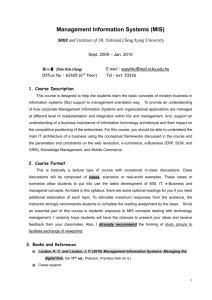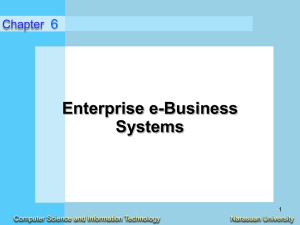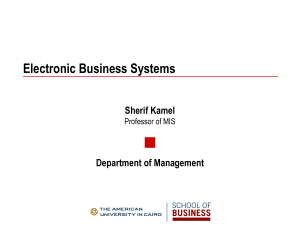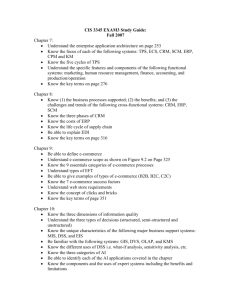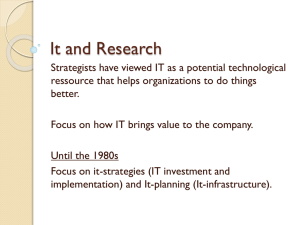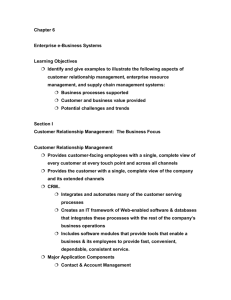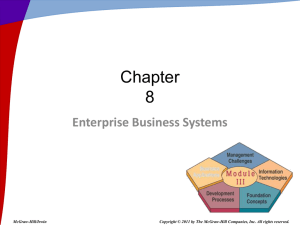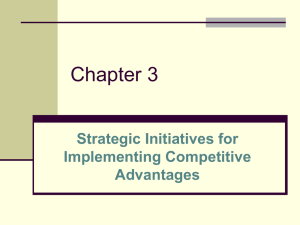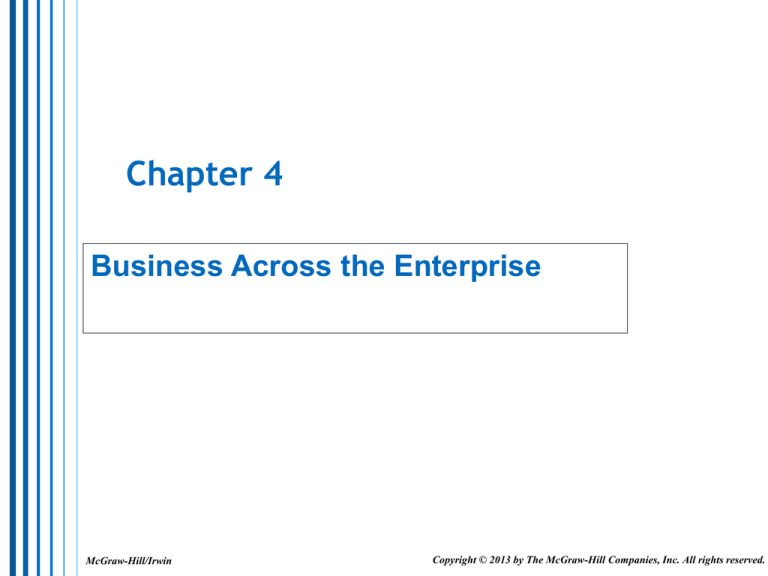
Chapter 4
Business Across the Enterprise
McGraw-Hill/Irwin
Copyright © 2013 by The McGraw-Hill Companies, Inc. All rights reserved.
Learning Objectives
Identify and give examples to illustrate the
following aspects of customer relationship
management, enterprise resource
management, and supply chain management
systems:
Business processes supported
Customer and business value provided
Potential challenges and trends
8-2
Learning Objectives
Understand the importance of managing at the
enterprise level to achieve maximum
efficiencies and benefits.
8-3
Section 1
Customer Relationship Management:
The Business Focus
8-4
I. Introduction
Businesses today must be
Customer-centric/Customer-focused –
Customer, Customer, Customer!
8-5
II. What Is CRM?
Providing the organization with a single
complete view of every customer, and
providing the customer with a single complete
view of the organization and its extended
channels
8-6
Customer Relationship
Management (CRM)
Traditional Marketing
CRM
Goal: Expand customer
base, increase market
share by mass marketing
Goal: Establish a profitable,
long-term, one-to-one
relationship with customers;
understanding their needs,
preferences, expectations
Product oriented view
Customer oriented view
Mass marketing / mass
production
Mass customization, one-toone marketing
7
8-7
Contact and Account Management
• Capture and Track relevant data about
– Every past and planned contact with prospects
and customers
– Other business and life cycle events
• Data captured from touch points
– Telephone, fax, e-mail
– Websites, retail stores, kiosks
– Personal contact
8-8
Marketing and Fulfillment
• Automate direct marketing campaigns
– Qualifying leads for targeted marketing
– Scheduling and tracking mailings
– Capturing and managing responses
– Analyzing the business value of the campaign
– Fulfilling responses and requests
8-9
Customer Service and Support
• Shared database
– Requests for service are created, assigned,
and managed
– Call center software routes calls to agents
– Help desk software provides service data
and suggestions for solving problems
• Personalized support information
8-10
Retention and Loyalty Programs
• Primary objective - enhancing and
optimizing customer retention and loyalty
– Identify, reward, and market to the most loyal
and profitable customers
– Evaluate targeted marketing and relationship
programs
8-11
III. The Three Phases of CRM
Acquire – CRM helps a new customer
perceive value of a superior product/service
Enhance – CRM supports superior customer
service, and cross-selling/up-selling
Retain – CRM helps proactively identify and
reward the most loyal and profitable
customers
8-12
Benefits of CRM
• Identify and target the best customers
• Real-time customization and
personalization of products and services
• Track when and how a customer contacts
the company
• Provide a consistent customer experience
• Provide superior service and support
8-13
CRM Failures
• Reasons for Failure
– Lack of senior management sponsorship
– Improper change management
– Elongated projects that take on too much, too
fast
– Lack of or poor integration between CRM and
core business systems
– Lack of end-user incentives leading to poor user
adoption rates
– Lack of understanding and preparation
– Not solving business process problems first
– No participation on part of business stakeholders
involved.
8-14
Section 2
Enterprise Resource Planning:
The Business Backbone
8-15
I. Introduction
ERP is a multifunctional enterprisewide backbone that
integrates/automates business processes and information
systems.
For example, ERP software for a manufacturing company will
typically process the data from and track the status of sales,
inventory, shipping, and invoicing, as well as forecast raw
material and human resource requirements
II. What is ERP?
A cross- functional software suite supporting basic internal
business processes of a firm.
Enterprise resource planning is a cross-functional enterprise
system driven by an integrated suite of software modules that
supports the basic internal business processes of a company.
An ERP system is an attempt to integrate all functions across a
company to a single computer system that can serve all those
functions’ specific needs.
8-16
8-17
III. Benefits and Challenges of ERP
Major Business Value from ERP
Quality and Efficiency – significant improvements in
quality and efficiency of customer service, production,
and distribution
Decreased Costs – significant reductions in transaction
costs, hardware and software, and IT support staff
Decision Support – provides cross-functional
information that enables better decision making across
the enterprise
Enterprise Agility – breaks down
departmental/functional walls and enables more
flexible, adaptive organizational structures
8-18
III. Benefits and Challenges of ERP
Costs of ERP – if you do not do ERP properly
you can kill the firm
Causes of ERP Failures
underestimating the complexity of planning,
development, and training necessary for
success
Failure to involve affected employees
Trying to do too much too fast
Overreliance on claims of software
vendors/consulting firms
8-19
Section 3
Supply Chain Management:
The Business Network
8-20
I. Introduction
Starting a business takes ideas, capital, and
technical savvy. Operating one, however, takes
supply chain management (SCM) skills. A
successful SCM strategy is based on accurate
order processing, just-in-time inventory
management, and timely order fulfillment. SCM’s
increasing importance illustrates how a tool that
was a theoretical process 10 years ago is now a
hot competitive weapon.
That’s why many companies today are making
supply chain management (SCM) a top strategic
objective and major business application
development initiative.
8-21
II. What is SCM?
A cross-functional inter-enterprise system using
IT to support/manage links between key
business processes and suppliers, customers,
and business partners
• Helps a company to
–
–
–
–
–
Get the right products
To the right place
At the right time
In the proper quantity
At an acceptable cost
8-22
III. The Role of SCM
• To optimize the effective/efficient movement
of materials between suppliers, customers, and
other partners
8-23
Benefits of SCM
• Key Benefits
– Faster, more accurate order processing
– Reductions in inventory levels
– Quicker times to market
– Lower transaction and materials costs
– Strategic relationships with supplier.
8-24
Challenges of SCM
• Key Challenges
– Lack of knowledge, tools, and guidelines
– Inaccurate data
– Lack of collaboration
– SCM tools are immature, incomplete, and
hard to implement
8-25



